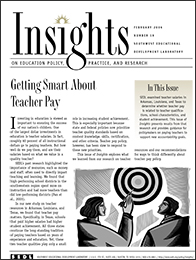How Well Do We Pay Our Teachers?
Salary schedules reflect state, regional, and local variations in pay. The same teacher experience and education garners different pay levels in different states, districts, and schools.
According to national statistics, states in the southwestern region all pay their teachers less than the national average. Among the five southwest states in our region, the highest paying state’s average salary ($40,476) is 15 percent higher than the lowest paying state ($35,061) (see Figure 3).
Figure 3: Average Teacher Salaries

Note. From American Federation of Teachers, 2005.
Teacher Pay in High-Need Schools
Knowing that teacher pay can vary, we sought to find out more about differences, especially for teachers in high-need schools. We found that not only do teachers need more pay to keep up with the national average, but salaries differ based on locale, student population, and school achievement level.
Some of the lowest paid teachers were in rural schools with high student poverty rates and low student achievement. Teachers in these schools were paid less than teachers in rural schools with wealthier, higher-achieving students.
As we show in Figure 4, the teacher pay gap between rural, suburban, and urban districts is noteworthy. The largest is an 18 percent pay gap between rural and urban districts in Arkansas where nearly 40 percent of all teachers are in rural districts.
Figure 4: Average Teacher Salaries in Urban, Suburban, and Rural Districts

Note. From Arkansas Department of Education (2002–2003), Louisiana Department of Education (2002–2003), and Texas Education Agency (2001–2002).
It is important to understand that teachers were paid less in rural locations regardless of their experience. Teachers in rural districts in Arkansas and Texas actually had more experience, on average, than urban teachers.
Teacher Pay and Student Achievement
What everyone wants to know is whether teacher pay matters to student achievement.
What we found is teacher salaries are related to student achievement for math and reading in Texas and for reading in Arkansas. However, teacher pay did not impact math scores in Arkansas nor achievement generally in Louisiana.
These findings are inconclusive and point to the difficulty in fully explaining the role of salaries on student achievement. The findings fall short of providing clear guidance for state or local pay policy. We still do not know why salaries seem to matter or on what criteria we should be increasing teacher pay.
For example, a simple comparison of salary averages (see Table 1) tells us that teacher pay levels in high-performing versus low-performing districts are already on par.
Table 1: Average Teacher Salary in Highest- and Lowest- Performing Districts
| State | Lowest-Performing Districts (8th-grade math) | Highest-Performing Districts (8th-grade math) | Percent Difference |
|---|---|---|---|
| Arkansas | $36,570 | $36,705 | 0.4 |
| Louisiana | $34,340 | $34,992 | 1.9 |
| Texas | $38,733 | $38,248 | 1.3 |
Note. From Arkansas Department of Education (2002–2003), Louisiana Department of Education (2002–2003), and Texas Education Agency (2001–2002).
Next Page: Thinking Differently About Teacher Pay

